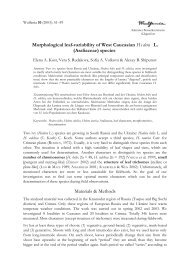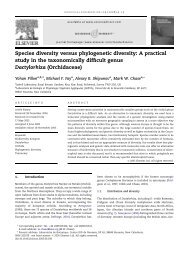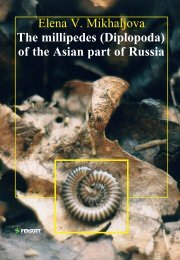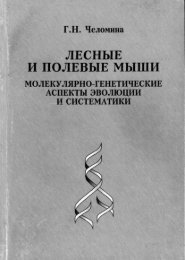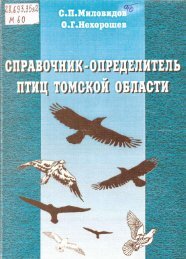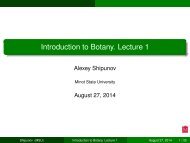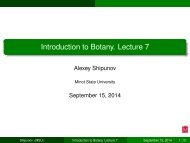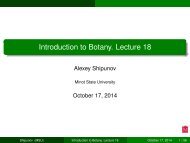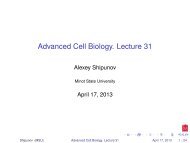Introduction to Botany. Lecture 14 - Materials of Alexey Shipunov
Introduction to Botany. Lecture 14 - Materials of Alexey Shipunov
Introduction to Botany. Lecture 14 - Materials of Alexey Shipunov
You also want an ePaper? Increase the reach of your titles
YUMPU automatically turns print PDFs into web optimized ePapers that Google loves.
<strong>Introduction</strong> <strong>to</strong> <strong>Botany</strong>. <strong>Lecture</strong> <strong>14</strong><strong>Alexey</strong> <strong>Shipunov</strong>Minot State UniversityOc<strong>to</strong>ber 3, 20<strong>14</strong><strong>Shipunov</strong> (MSU) <strong>Introduction</strong> <strong>to</strong> <strong>Botany</strong>. <strong>Lecture</strong> <strong>14</strong> Oc<strong>to</strong>ber 3, 20<strong>14</strong> 1 / 10
Outline1 Questions and answers2 Life cycleBasics<strong>Shipunov</strong> (MSU) <strong>Introduction</strong> <strong>to</strong> <strong>Botany</strong>. <strong>Lecture</strong> <strong>14</strong> Oc<strong>to</strong>ber 3, 20<strong>14</strong> 2 / 10
Outline1 Questions and answers2 Life cycleBasics<strong>Shipunov</strong> (MSU) <strong>Introduction</strong> <strong>to</strong> <strong>Botany</strong>. <strong>Lecture</strong> <strong>14</strong> Oc<strong>to</strong>ber 3, 20<strong>14</strong> 2 / 10
Questions and answersPrevious final question: the answerWhat is the difference between anaphase I <strong>of</strong> meiosis and anaphase<strong>of</strong> mi<strong>to</strong>sis?<strong>Shipunov</strong> (MSU) <strong>Introduction</strong> <strong>to</strong> <strong>Botany</strong>. <strong>Lecture</strong> <strong>14</strong> Oc<strong>to</strong>ber 3, 20<strong>14</strong> 3 / 10
Questions and answersPrevious final question: the answerWhat is the difference between anaphase I <strong>of</strong> meiosis and anaphase<strong>of</strong> mi<strong>to</strong>sis?Meiosis: homologous chromosomes will go independently <strong>to</strong>different polesMi<strong>to</strong>sis: halves <strong>of</strong> every chromosome go <strong>to</strong> different poles<strong>Shipunov</strong> (MSU) <strong>Introduction</strong> <strong>to</strong> <strong>Botany</strong>. <strong>Lecture</strong> <strong>14</strong> Oc<strong>to</strong>ber 3, 20<strong>14</strong> 3 / 10
Life cycleBasicsLife cycleBasics<strong>Shipunov</strong> (MSU) <strong>Introduction</strong> <strong>to</strong> <strong>Botany</strong>. <strong>Lecture</strong> <strong>14</strong> Oc<strong>to</strong>ber 3, 20<strong>14</strong> 4 / 10
Life cycleBasicsSimple life cycle: unicellular organismAssociated terms: mi<strong>to</strong>sis, meiosis (R!), syngamy (Y!), reproduction, sexual reproduction,asexual reproduction, vegetative reproduction, isogamy, heterogamy, oogamy, zygote, gamete,male, female, sperma<strong>to</strong>zoon, oocyte<strong>Shipunov</strong> (MSU) <strong>Introduction</strong> <strong>to</strong> <strong>Botany</strong>. <strong>Lecture</strong> <strong>14</strong> Oc<strong>to</strong>ber 3, 20<strong>14</strong> 5 / 10
Life cycleBasicsSimple life cycle: unicellular organismn−Cells = gametesZygotenn+Y!2nVegetativereproductionSexual reproductionnAsexual reproductionR!2nnnAssociated terms: mi<strong>to</strong>sis, meiosis (R!), syngamy (Y!), reproduction, sexual reproduction,asexual reproduction, vegetative reproduction, isogamy, heterogamy, oogamy, zygote, gamete,male, female, sperma<strong>to</strong>zoon, oocyte<strong>Shipunov</strong> (MSU) <strong>Introduction</strong> <strong>to</strong> <strong>Botany</strong>. <strong>Lecture</strong> <strong>14</strong> Oc<strong>to</strong>ber 3, 20<strong>14</strong> 5 / 10
Life cycleBasicsMulticellularity, or Origin <strong>of</strong> DeathSometimes, cells do not part after mi<strong>to</strong>sis. These simple cellaggregates may benefit from their size (e.g., harder <strong>to</strong> swallow)and putative division <strong>of</strong> labor (e.g., capture light from differentsides and share products <strong>of</strong> pho<strong>to</strong>synthesis)Next step is <strong>to</strong> separate germ cells and somatic cells. Somaticcells with eventually die whereas germ cells may give an <strong>of</strong>fspring.This is the beginning <strong>of</strong> multicellularity.Life cycles <strong>of</strong> multicellular organisms are based on interleavinggaplont and diplont, the second is making spores<strong>Shipunov</strong> (MSU) <strong>Introduction</strong> <strong>to</strong> <strong>Botany</strong>. <strong>Lecture</strong> <strong>14</strong> Oc<strong>to</strong>ber 3, 20<strong>14</strong> 6 / 10
Life cycleBasicsGeneral life cycle: multicellular organism<strong>Shipunov</strong> (MSU) <strong>Introduction</strong> <strong>to</strong> <strong>Botany</strong>. <strong>Lecture</strong> <strong>14</strong> Oc<strong>to</strong>ber 3, 20<strong>14</strong> 7 / 10
Life cycleBasicsGeneral life cycle: multicellular organismHaplontnSporeVegetativereproduction(fragments ormi<strong>to</strong>spores)nGamete mother cellGeneral (sporic) life cycleSporesnnMAsexualreproduction:Sexualreproduction:nGametangiumSporangiumnGametic (human) life cycleMeiosisR!Vegetativereproduction(fragments ormi<strong>to</strong>spores)Spore mother cell2nn+GametesSyngamy(isogamy type)Diplont2nY!n–2nZygoteZygotic life cycle<strong>Shipunov</strong> (MSU) <strong>Introduction</strong> <strong>to</strong> <strong>Botany</strong>. <strong>Lecture</strong> <strong>14</strong> Oc<strong>to</strong>ber 3, 20<strong>14</strong> 7 / 10
Life cycleFinal question (2 points)Basics<strong>Shipunov</strong> (MSU) <strong>Introduction</strong> <strong>to</strong> <strong>Botany</strong>. <strong>Lecture</strong> <strong>14</strong> Oc<strong>to</strong>ber 3, 20<strong>14</strong> 8 / 10
Life cycleFinal question (2 points)BasicsIn most organisms, cells participating in syngamy are unequal(male and female).Why?<strong>Shipunov</strong> (MSU) <strong>Introduction</strong> <strong>to</strong> <strong>Botany</strong>. <strong>Lecture</strong> <strong>14</strong> Oc<strong>to</strong>ber 3, 20<strong>14</strong> 8 / 10
SummaryLife cycleBasicsMi<strong>to</strong>sis is a process <strong>of</strong> cell multiplication, ploidy stays constant,genotype does not change. Chromosomes split.Syngamy is a sexual process <strong>of</strong> cell fusion, ploidy doubles,genotype changes. Chromosomes meet.Meiosis is a process <strong>of</strong> reduction <strong>of</strong> DNA amount, ploidy halves,genotype changes. Chromosomes separate, then split.<strong>Shipunov</strong> (MSU) <strong>Introduction</strong> <strong>to</strong> <strong>Botany</strong>. <strong>Lecture</strong> <strong>14</strong> Oc<strong>to</strong>ber 3, 20<strong>14</strong> 9 / 10
For Further ReadingLife cycleBasicsA. <strong>Shipunov</strong>.<strong>Introduction</strong> <strong>to</strong> <strong>Botany</strong> [Electronic resource].2010—onwards.Mode <strong>of</strong> access:http://ashipunov.info/shipunov/school/biol_154Th. L. Rost, M. G. Barbour, C. R. S<strong>to</strong>cking, T. M. Murphy.Plant Biology. 2nd edition.Thomson Brooks/Cole, 2006.Chapter 12 (skip the angiosperm life cycle!.<strong>Shipunov</strong> (MSU) <strong>Introduction</strong> <strong>to</strong> <strong>Botany</strong>. <strong>Lecture</strong> <strong>14</strong> Oc<strong>to</strong>ber 3, 20<strong>14</strong> 10 / 10




